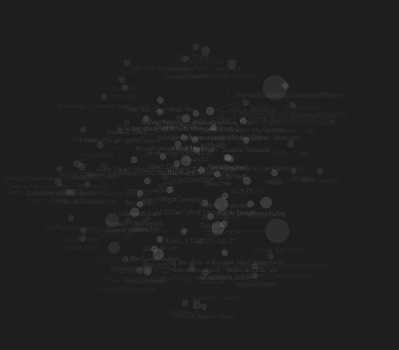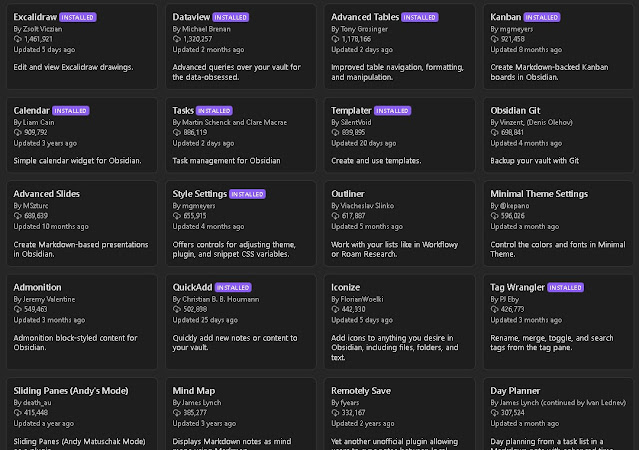4. Ode to Obsidian, the notetaking wonder
 | |
|
Oh Obsidian, how I love thee. The image above (Fig. 1) is a graphical display of what I have poured into it. Each node is a note. Each line a connection to another note. It is, in a nutshell, a writing app that allows you to link your notes together. I have used it to connect all my NPCs, campaign status documents (Thank you Justin Alexander), locations, items, creatures, player characters, and lightbulb ideas together in a way that is incredibly chaotic but immediately accessible and searchable. I think there are platforms out there that are built for just the purpose of managing a campaign but I don't think they are as freeform and I haven't tried them. With Obsidian, you can link a note about a particular creature to the day in your life you found it, the TTRPG book you found it in, and the movie that gave you the inspiration for its new abilities all in one go. Opening one of these notes will reveal its connection to the other notes along with any additional connections you have made. You can see an example of this in the figure below, where the bottom of the campaign document I made shows that it is connected to some day notes, the book note it was mentioned in (we need to talk about Break!! at some point), a Hex map of content, and a friend note (Fig 2.).
What is special about the linking system is that it helps with notes being written down and disappearing into the void. The more links you make with a note, the more likely it is to resurface. You might forget that you made a NPC that lives in a particular town and has access to a specific service, until you pull up that location or service note as the player characters arrive there 10 sessions after the NPC was created. I find that stuff like this happens all the time, as long as you are in the habit of checking your links at the bottom when you open a note, or taking a glance at the local graph (Fig 3).
 |
| Fig 3. The local graph only shows connections to the open note vs the mess in fig. 1. You can find it by right clicking on the tab at the top for that note |
There are some other notable advantages which I believe make it special. You can open any note in your vault (your collection of notes) within seconds using the quick switcher which you can tie to a hotkey. You can do a global search through the contents of all of your notes to find whatever it is you are looking for which is also very fast, even when you have hundreds of notes. Also the notes are stored offline locally on your computer as text files, making them more futureproof than something stored on the web or in a unique format that may lose support. Being able to use the program offline is also very nice when that situation comes up (Internet goes out etc.). There are many options out there for syncing your notes between devices, which I won't get into here.
One of my absolutely favorite things is how customizable it is. There are a lot things you can tweak to your liking in stock obsidian like appearance and hotkeys, but the magic happens when you use the community plugins. If the program isn't doing something you would like it to, there is more often than not a plugin which has the fix or the feature you are looking for, and you can install them directly from the app (Fig. 4) . There are some that are TTRPG specific too, but I don't really use those as they are more 5e focused. My favorite plugins have added kanban boards (Kanban), functional drawings that you can link to specific notes (Excalidraw, which is great for maps), tables that automatically add entries if they contain certain information (Data view), and customizable templates that can auto populate information that you enter frequently (Templates, which is native, or Templater).
 |
| Fig 4. A few of the many community plugins available for Obsidian |
It is little intimidating when you first start it up. There is no structure because it doesn't exist yet. You get to shape it into exactly how you think. I recommend starting with something like post-session notes, where you can start to link information regarding NPCs, player characters, locales and whatever comes to mind as you write. All you have to do is put double brackets around the thing you want to link and it becomes a new note the next time you click on it (Fig 5.). As soon as you put the double brackets down the next time you want to mention that thing, it will be a note you can select from list (Fig. 6). Not that bad right? From there you can start to figure out how you want to organize things, if at all. I used to shove things in a lot of folders and now I mostly just use the quick switcher and search tools to pull out what I need. The links will lead me to other things of interest by themselves.




ReplyDeleteComparing Obsidian to the Room of Requirement is apt.
Do you think there are any downsides to Obsidian or at least, things that potential users should consider as a possible point of friction? I guess that would be some hurdles in being able to easily access the full markdown between different computers?
I really appreciated the gifs btw!
It saves what you write as you write it, so you don't have to think about saving at all, but some people like version control, which you can still due by copying notes.
DeleteIt really shines when used on a computer, but it is still very capable on a phone. Highly recommend getting a bluetooth keyboard if anyone goes the phone route. You probably have a phone already and getting a keyboard is cheaper than getting a new computer.
Finding a syncing solution can be a hassle if you don't want to tip Obsidian each month. I love how hassle free their sync service is and it is very much integrated into my life. I don't think that many will be syncing between devices, but if you need to for free, just stick your vault into a shared folder like icloud, google drive, or dropbox and open the vault from their on each device. That worked just fine for me initially until my vault got really massive.
Many of the downsides of Obsidian are fixed with the community plugins but you have to either search for "best obsidian plugins" or browse the associated subreddit. I wasn't quire sure how to use it at first until I watched a couple of videos on YouTube. Nicole van der Hoeven has some DND focused content on that. I think a lot of people download obsidian and expect it to live up to the hype right out of the gate, when it has to be tuned specifically to their needs. I think a lot of people are not aware of all the features obsidian has natively (tabs, bookmarks, tab pinning, canvas, local graphs, tag organization, templates, dragging panes into new windows etc. ).
Also, I mention this in the blog post, but turn on backlinks in text under the core plugins. Programs like Notion show links between documents but where Obsidian shines is its ability to show the context in which a link was mentioned.
It uses Markdown to format text which may be foreign for some at first, but it will become second nature after some constant usage. The beauty of the files being markdown documents is you can open it with any text editor like notepad and understand that #, ##, ### are different layers of headings, the - symbol is a bullet point, - [ ] is a checkbox, etc. Obsidian just translates that into formatting. It means that even if you don't have Obsidian you can open the files on any device and read them without issue.